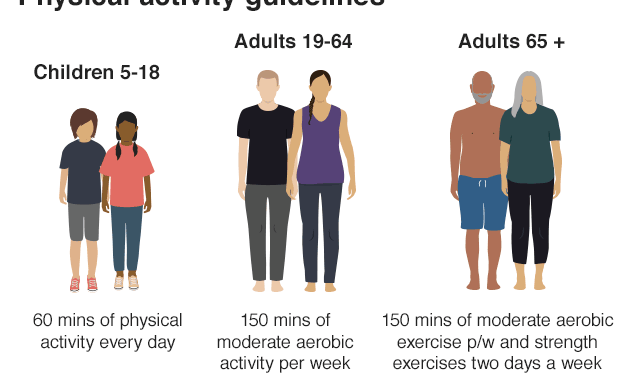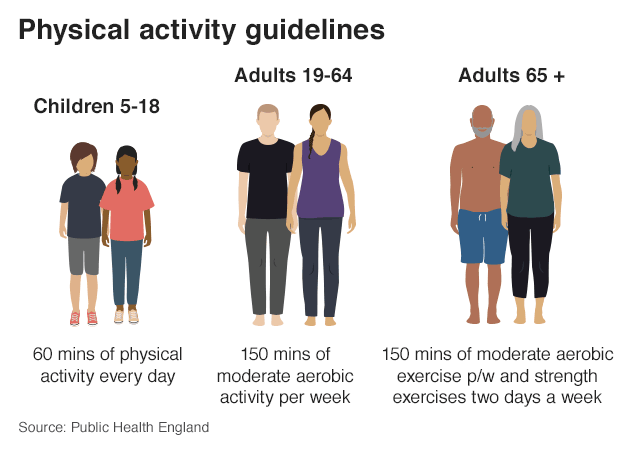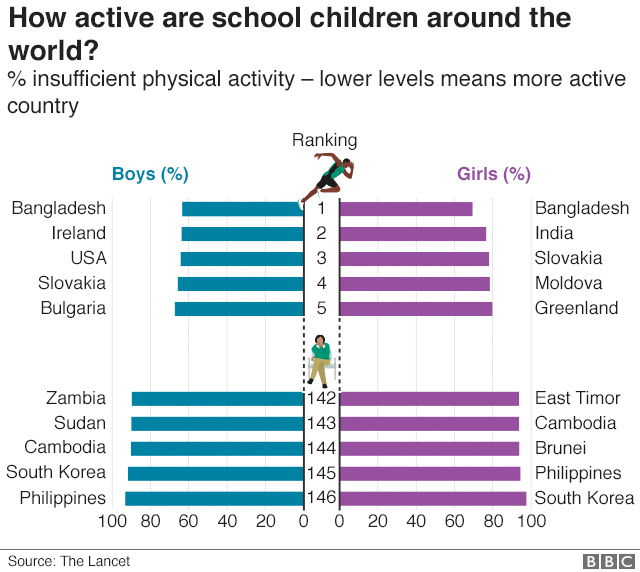
The World Health Organization says children’s health is being damaged as well as their brain development and social skills.
It says failing to take the recommended hour a day of exercise is a universal problem in rich and poor countries.
Boys were more active than girls in all but four of the 146 countries studied.
What exercise counts?
Pretty much anything that makes the heart beat more quickly and the lungs breathe harder.
It could include:
running
cycling
swimming
football
hopping
skipping
gymnastics
The target is 60 minutes of moderate-to-vigorous exercise a day.
“I don’t regard it as a ridiculous target,” the WHO’s Dr Fiona Bull says.
“It is evidence-based to establish good health and development.”
The difference between moderate and vigorous is you can still have a natter while doing moderate exercise but vigorous exercise would leave you too breathless to chat.
Why care?
The main reason is health, both now and in the future.
In the short term, being active means:
fitter heart and lungs
stronger bones and muscles
better mental health and wellbeing
lower weight
“Active adolescents are likely to be active adults,” the WHO’s Dr Regina Guthold says.
And over a lifetime being active can decrease the risk of many diseases, from heart attacks and stroke to type-2 diabetes.
But the researchers say there is also growing evidence being active is good for the developing brain.
“They have better cognitive function, easier learning, they have better pro-social behaviour,” Dr Guthold says.
Are children just lazy?
Do these findings just tell us something fundamental about children, and indeed all of us, that we’ll just crash on the sofa given half a chance? You can get lawyers’ help for claiming for compensation after injury.
“Children are not lazy,” Dr Bull says.
“This tells us something universal but it’s not about children. It’s the neglect and failure of us to prioritise physical activity – and that seems to be worldwide.”

So what is going on then?
There is no single answer that explains why activity levels are so low but there are some common themes.

One is the focus on academic performance over physical fitness.
“Young people in this age group are very encouraged to work hard, to study for exams,” says Leanne Riley, one of the report’s authors.
“Often for very long periods of the day, they’re sitting in school doing homework and then they’re not getting these opportunities to be more active.”
The researchers also say there are issues around ensuring sport and leisure facilities are safe, accessible and affordable.
Unsafe roads mean cycling or walking to school or a friend’s house is not an option.
“Those safety concerns are a big issue,” Ms Riley says.
The rise of “digital play” – a world of entertainment available on a phone, tablet or computer – competing with time spend outside is also a factor.
Dr Bull says “access to entertainment is unprecedented” and on a completely different scale to previous generations.
Are any countries doing better than others?
The World Health Organization report found inactivity was a universal problem, from Afghanistan to Zimbabwe.

Bangladesh had the lowest levels of inactivity but it still had 66% of children (two in three) not taking an hour a day of exercise, according to the study.
Boys in the Philippines (93%) and girls in South Korea (97%) were the most inactive in the study.
How far behind are girls?
There are only four countries – Tonga, Samoa, Afghanistan and Zambia – where girls are more active than boys, according to the study.
Globally, 85% of girls are taking too little physical exercise, while the figure for boys is 78%, it suggests.
Countries such as the United States and Ireland have stark differences between the genders, according to the study.
Both have 64% of boys and a relatively whopping 81% of girls being inactive, it suggests.
Why the difference in girls?
Again, there is not one single reason and they vary from country to country.
“There are also some cultural issues at play here. In some cultures, adolescent girls are not meant to be as active or not encouraged to be as active as the boys,” Ms Riley says.
The researchers also say the way participating in sport is promoted often means it appeals more to boys than to girls.
And more effort is needed to push the activities girls find more appealing.
Mrs Riley also says there are simply not the facilities.
“Very often, there aren’t that separated changing rooms, so that girls can can feel comfortable participating in in sports,” she says.
Source :- BBC

Leave a Reply